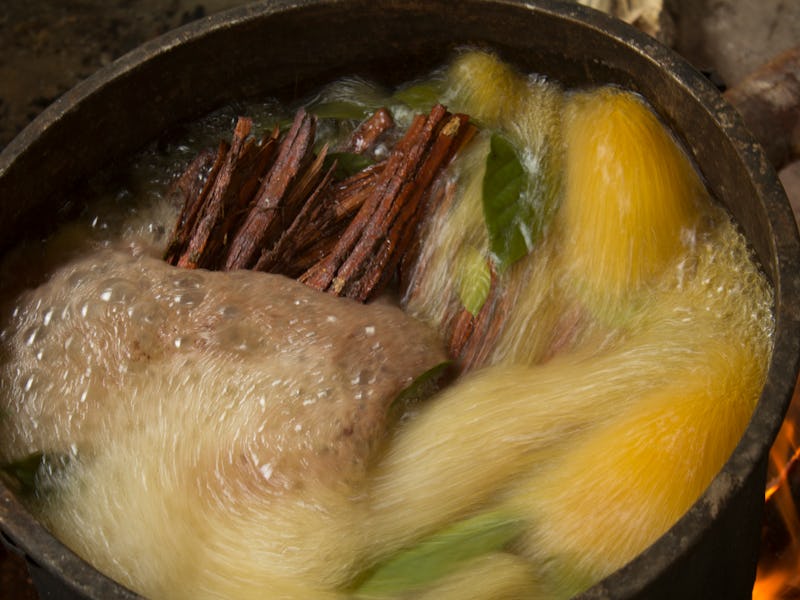Ayahuasca's Power Comes From the One-Two Punch of Anti-Depressants and DMT
Many drugs come from the jungle. Some stay there.

Ayahuasca is the vodka and Red Bull of psychedelics in that it contains both a mind-altering substance and a means of efficient delivery. DMT is to alcohol as alkaloids are to sugar. This is why the drug packs such a heavy punch and presumably why it has been used for centuries by the indigenous peoples of Amazonian Peru in shamanistic ceremonies. It is also the reason that chemically or spiritually adventurous Westerners, like those featured in Hulu’s The Path, a show loosely based on the rituals of real-life Brazilian-American ayahuasca cults like Sainto Daime and Unio do Vegetal (“the union of the plants”), have embraced the stuff. For all of its purported life-altering effects, the drug’s mechanisms aren’t all that revolutionary, working in much the same way as modern-day antidepressants.
In the Quechua language, which is spoken in Peru and Chile, the huasca in ayahuasca refers to “woody vine” and the aya, loosely, to “dead body.” The woody vine in question refers, most of the time (shamanistic recipes aren’t exactly rigorous), to a plant called Banisteriopsis caapi, which is mashed up and boiled to make the base brew.
The muddy, herbal-tasting plant extract is a source of harmala alkaloids, chemical compounds that are known monoamine oxidase inhibitors — a common term to anyone who’s familiar with modern antidepressants like Marplan, Nardil, and Emsam, which use the same compounds. Monoamine oxidase is an enzyme in the brain that clears neurotransmitters like norepinephrine, serotonin, and dopamine from the spaces between neurons so they can’t signal anymore; compounds that inhibit it like the ayahuasca vines alkaloids keep those neurons firing, altering your mood.
B. caapi is an antidepressant trip on its own, but combined with a source of DMT — like the leaves of the Psychotria viridis plant, sometimes referred to as the “Queen of the Forest,” it’s a catalyst for a neurochemical explosion and a heady, occasionally life-altering, trance. That’s because the plant is a natural source of DMT (technically, N, N-dimethyltryptamine), a compound that drug nerds pretty much view as the pinnacle of spiritually enlightening substances, variously nicknaming it “the God drug” and “the spirit molecule.”
If you were to chew on P. viridis leaves alone, they wouldn’t really do much: The human body doesn’t love DMT, normally breaking it down through enzymes in the gut. But when you’ve got monoamine oxidase inhibitors in your system, DMT manages to sidestep destruction, diffusing past the enzymes and blood-brain barrier into the mind, where it works its magic.
Proponents of ayahuasca — most prominently, dudes of the Father John Misty, Sting, and Devendra Banhart variety — praise it for its ability to cause mind-bending psychedelic trips, spur spiritual awakenings, occasionally allow people to make contact with spirit guides, and purge, emotionally and physically. Shamans have been known to offer users rolls of toilet paper in addition to warning them about uncontrollable puking, but this, together with the rise in heart rate and blood pressure, is part of the experience. It’s also why ayahuasca can be used to get rid of parasitic worms, which is something almost no one brings up at Phish shows.
While most user accounts seem like banal stoner-talk — “It was like being on drugs in a dream,” one user told Inverse — there’s a growing amount of science showing that ayahuascas spiritual trips could be useful for treating mental illnesses like addiction and PTSD.
Still, this is pretty serious stuff. It’s best to vet your shaman — and, for good measure, your brew-swilling companions. While the drug isn’t normally known to induce violence, a highly publicized ayahuasca murder last year put would-be users and psychedelic research funders on pause. With great potency comes great irresponsibility.